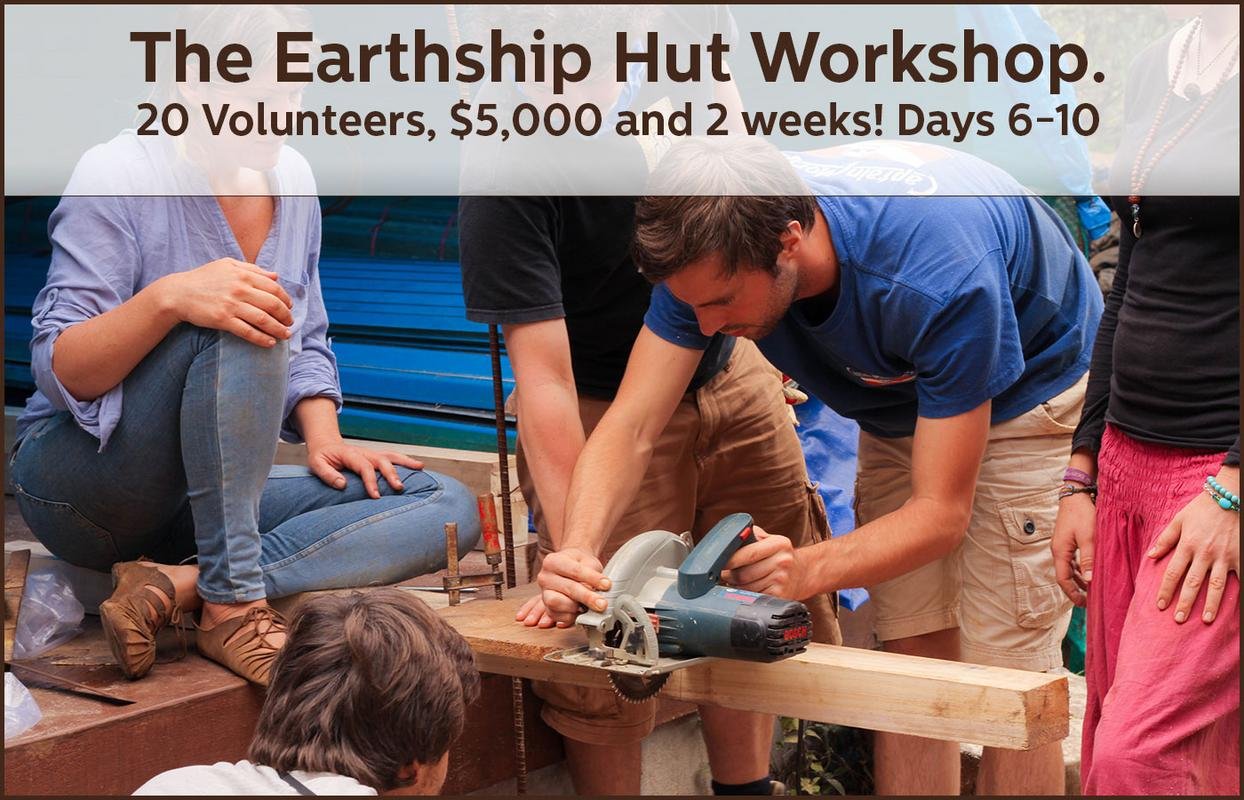
I meet hundreds of people every year who come to visit Earthship Karuna to learn more and be inspired. In fact I just had 8 guys from Madurai turn up at my door who are super keen to build something off-grid! Most of the people I meet are not builders, or architects, and nor do they want to be! What they do have is a desire to live off-grid any hopefully someday manifest their own home.
That was exactly the position I was in back in the year 2001 when I met Michael Reynolds, the inventor of Earthship Biotecture, in Brighton UK. I followed the path that led me to many countries, and over the course of nearly 15 years I found my way to finally achieving the great goal of self building, and finishing! I am sharing these stories to show you how we have built both big and very small off-grid homes. I also want you to see that people with no experience and a little guidance can self build successfully, and I hope to give you the inspiration and confidence that you can also do it!
We are building this very small Earthship Hut with a group of 'unskilled' volunteers. The thing is, when you invite a group of people you do end up with a few who are skilled in one thing or another. SO the group of around 30 people included, by chance, a couple of very good carpenters and maisoners. That really helped with the build, and isn't something that I had planned. I have noticed that this has happened on every build I have done like this, and I definitely recommend working with volunteers if you are self building. I have spent a lot of time teaching and working with volunteers. I understand the need to teach people, and I have put a huge amount of energy into spreading this knowledge as well as the skills needed to anyone ready to listen and learn.
By day 10 on this workshop build we had achieved a lot! We were nearly finished building the main walls with earth rammed tyre bricks, and work had begun on the roof framing. The roof is the most important part of a house (in my opinion) and I would like to talk a little bit about roof options and costs. The roof is usually the most expensive single part of a house. It can be made from just about any building material, and there are very cheap options and much more expensive options. When you live in a climate that gets quite cold, or hot, you will most likely need to start looking at more expensive options, although there is a very good cheap option that I will recommend. If there is one part of the house that you will most likely need some skilled help it is the roof!
So to help you understand some of the options open to you I will describe some of them from 'cheap n best' right up to 'Armageddon Proof'.
1. The Tin Sheet Roof

Very popular in developing countries such as India, China, South America etc, the tin sheet roof is probably the cheapest, quickest, and easiest way to waterproof your home. They are very thin and light and so require a minimal strength supporting structure. The supporting structure can also be made of anything rigid and strong enough to support the weight. This includes using wood sticks, timber, and metal frames. They will last many years and hold off just about any amount of rain!
The negatives of a Tin Sheet roof are plentiful! Many of the negatives can be compensated for by insulating the roof from the outside and or inside. This will reduce heat loss in cold climates, and over heating in hot climates. It will also reduce the noise of rain on the roof which can be very unsociable if you are trying to have a chat with someone above the sound of a million drops of water hitting metal just above your head. If you build a strong roof frame, you can easily add some thermal mass on top using dirt. The ideal scenario would be to add insulation (foam, natural fibers, cob etc) and then add the thermal mass on top of the insulation. Finally you can plaster over the whole thing and seal it as you would any plaster. This would make for a much better roof and wouldn't add too much to the cost.
2. The Pond Liner Roof
This approach can be used on roofs that are irregularly shaped. It can be even cheaper than the tin sheet roof if you make the framing from scavenged sticks and posts. Once you have a frame up you can simply pop a rubber membrane (EPDM, pond liner etc) on the top and secure it in place. This can then be covered with many things, including thatching or any material that will cover it. It will be waterproof provided it slopes well and doesn't have bad seams. You could even put a turf roof on it for a really beautiful and ecoFriendly approach.
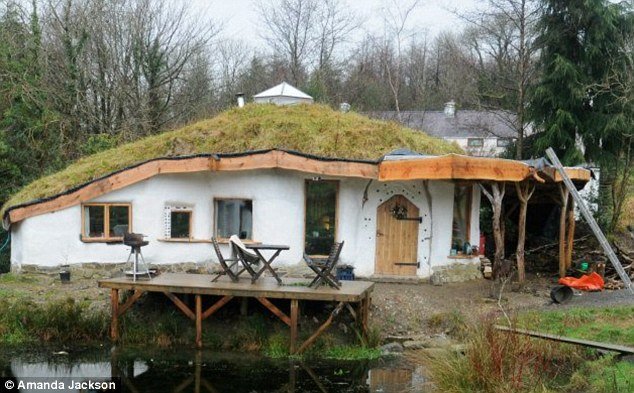
3. Ferro-cement Roof
A ferro-cement roof means a concrete roof reinforced with steel. Ferro-cement is a great option in many ways, but not the most ecoFriendly. You can make it any shape you like, and it can be covered with a liner an even turfed. It is very quick to make, and will have a very long life as it is very strong. When covered by an EPDM lining an turf it will not leak or buckle!
In this image you can see these homes are covered by a turf lawn for low visibility and incredible performance.
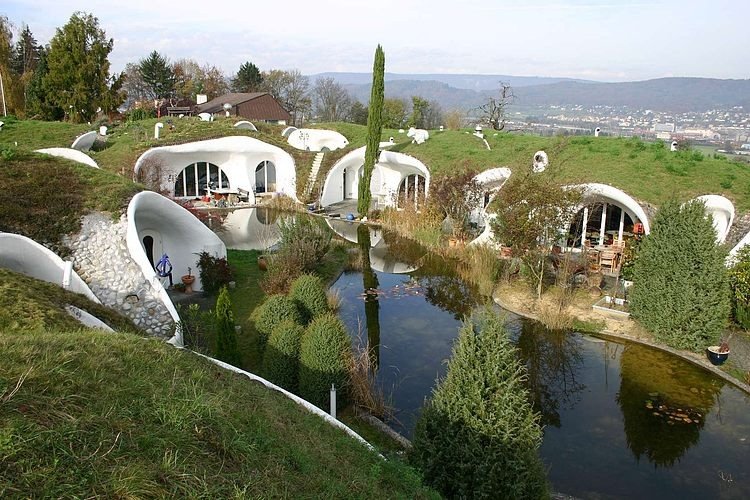
4. Roof Tiles
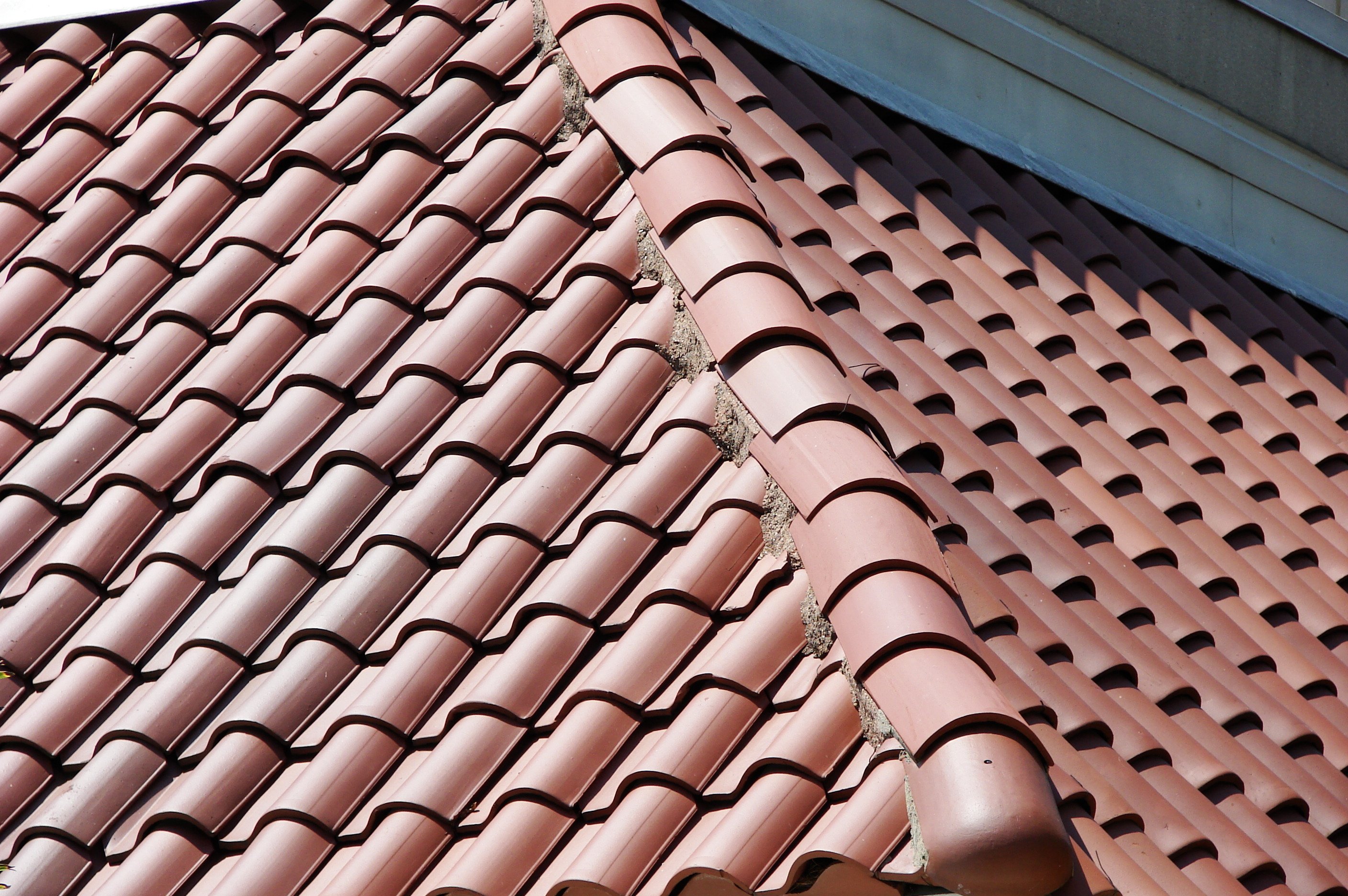
Tiles are a good option in many climates, especially dryer and hotter climates. They require a good wood framing that can be costly, but the tiles themselves are quite cheap and easy to replace. Therefore you can expect a lower maintenance cost with tiles if you do the framing well. They look beautiful and they also catch clean water with no toxins so they are very suitable for rainwater harvesting. In wet or damp climates you may want to consider one of the other options unless you are willing to spend!
5. Solar Tiles / Shingles
This is a very new option thanks to Tesla! It is definitely one worth mentioning as it combines solar power into special textured glass roof tiles that will give you power and last a very long time!
View the Video Promo!
6. Reciprocal Roof
This is a favourite option for people building round houses or yurts. They can be made using logs or long pieces of wood and allow you to create a roof that needs no central pillar or support. You can put them up just with rope if its temporary, and they are one of the easier options. If you are making a permanent reciprocal roof you will want to seal it with a good membrane an insulate it well.

7. Earthbag!
Now this is one option that I am dying to try out! Earthbag roofs are always round, and can only be made on a round house. They are very cheap indeed, and very heavy and strong. They can perform as well as if not better than any other kind of roof. To cap it all, they are made using dirt and special plastic sacs. They work in a similar principal to how arches self support, and if made well will last indefinatley with much less maintenace than a normal roof. I hope to try this and then report on it! If you want cheap, low tech and high performance, then this is the best in my opinion. I would only advise you work with an experienced person on this as IM sure you would be squashed quite flat if that came down on you!
Here is a pretty crazy earthbag home under construction. Note that you do plaster it afterwars so that it looks natural
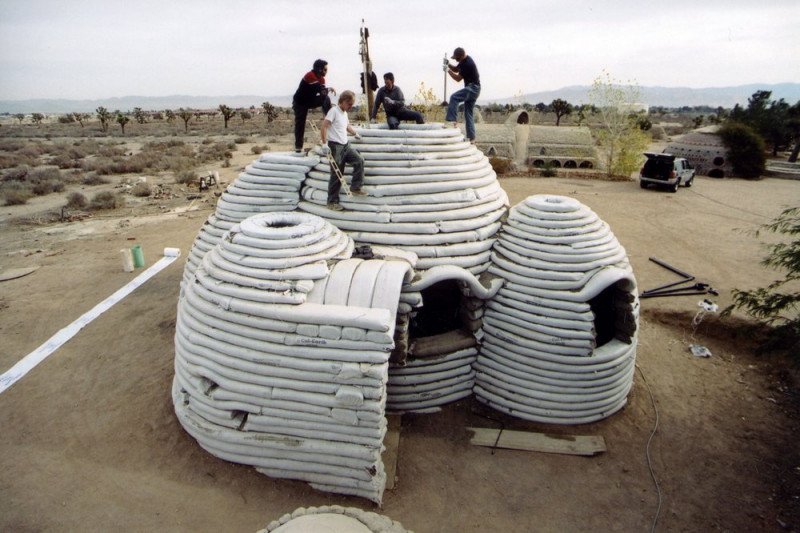
There are of course more options but you get the idea now. Your decision will depend on your own priorities an budget and is one of the most important decisions you will make for your home.
For the Earthship hut we went with a sloped V shaped Tin Sheet roof as that was what the owner wanted and we had almost no budget. I did suggest he at least insulate it with coconut hair, but that was never done. Since we are in a very mild climate it never gets that cold to need a well insulated building. With the thermal mass from the walls, and 6 people sleeping and cooking inside it will be just fine. If you do live in a colder climate, or have cold winters, then insulating is a must.
Luckily we had @nature-jon on hand, plus some super keen volunteers who helped him build the timber framework ready to assemble on the tyre walls. We made it using some basic power tools such as a circular saw and drill etc. It is pretty low tech but does need a careful eye and good joinery work. The frame would be attached to the tyre walls using the most simple method since the hut is so small. If you are building a bigger structure you will always need a bond beam that is put on the top of the final course of tyres. This bond beam can be made from wood, or concrete, or even steel reinforced concrete. The main purpose of this bond beam is to stabilise the walls and prevent them from toppling over. Since the roof frame was made of wood, and the hut was small, we just used the roof frame as the bond beam. The wood was attached to the tyre walls by embedding bolts into the tyres with cement and then bolting the roof frame to it.
Here you can see the bolts sticking out of the concrete. The tyres are just underneath it.

Here is the most simple kind of bond beam, suitable for tiny houses and can be made from wood scraps.
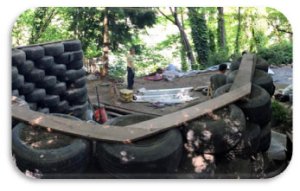
Watch a great 6 minute movie of some guys making a nice strong bond beam with concrete
Here you can see some of our volunteers helping to make our Frame / Bond Beam
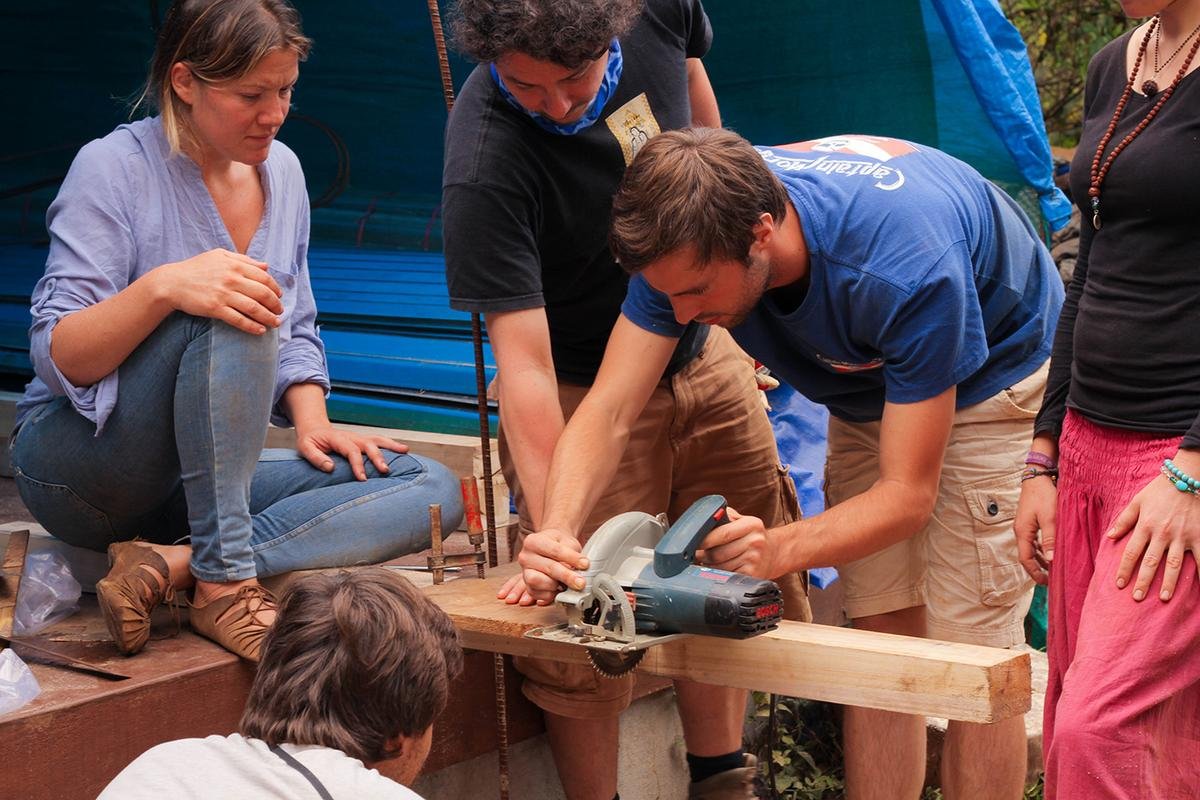
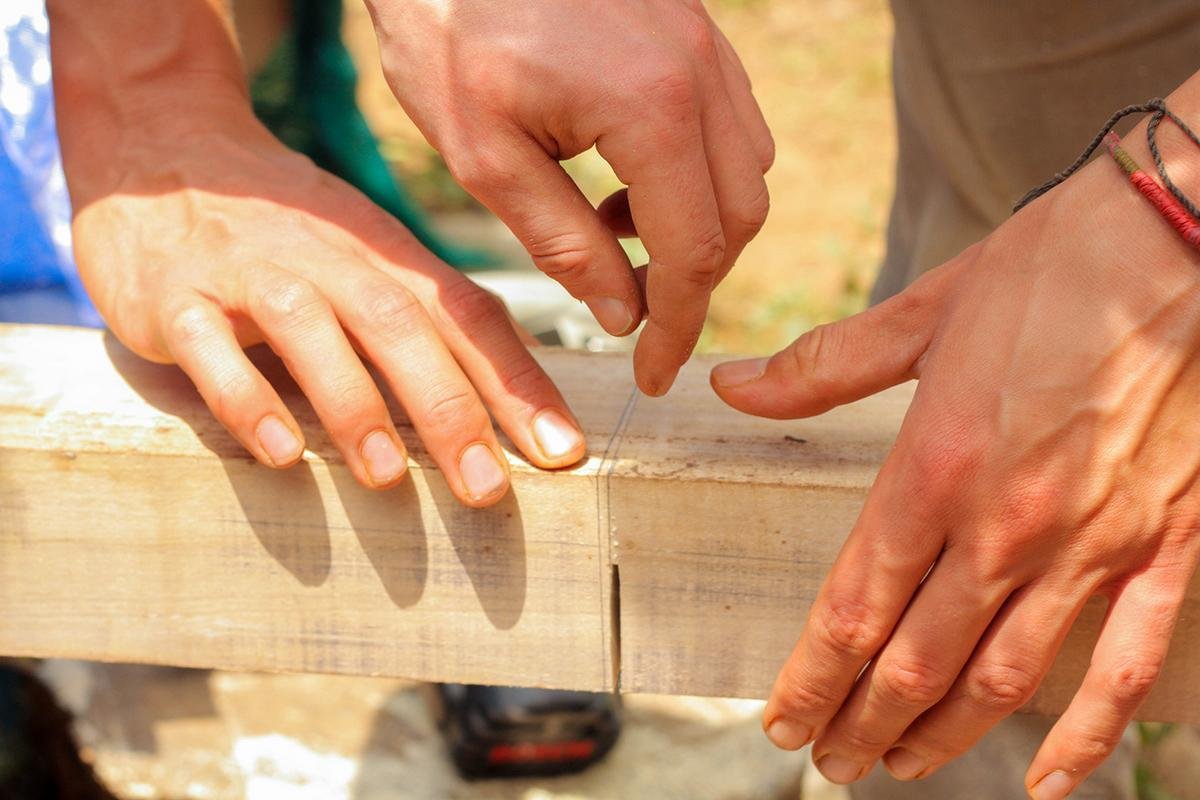

READ PREVIOUS POSTS
THE EARTHSHIP HUT BUILD: DAYS 2-5.
Why tyres make the ultimate eco-building material and how to build with them
EARTHSHIP SELF BUILD WORKSHOP:
DAY 1 THE BEGINNING!
The time has come for us to stop thinking and dreaming, and to start eco-building!
Just Do It! Watch This!

Thanks for being here with me and the #ecotrain!
We are a small community that support each other because we love what we write
about things that help make the world a better place

check our our ecoTrain magazine at @ecotrain



